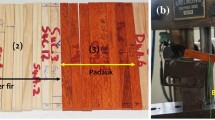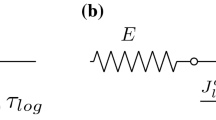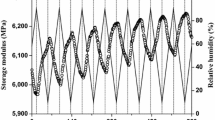Abstract
In softwood material, the coupling between mechanical loading and hydric state is known as the mechanosorptive effect. However, the coupling with viscoelastic effect remains unclear so far, especially when the loading is controlled by strain. In this context, the present paper is focused on the process of creation and recovery of ‘hygrolock’ behaviour, i.e. a stress locking effect which occurs in a phase of drying under load. For this purpose, several relaxation tests were first performed on small-scale silver fir specimens in order to express the relaxation function in terms of the ambient humidity. Then, two mechanosorptive tests were carried out in order to induce hygrolock stresses in the same sample loaded in sustained strain condition, and subjected to cyclically varying humidity. Based on the assumption of stress partition, the analysis of the test results clearly shows the existence of a hygrolock stress. From these experimental evidences, a law is finally proposed to describe the evolution of the hygrolock stress in terms of the hydric state of the softwood material.










Similar content being viewed by others
References
Armstrong LD, Kingston RST (1960) Effect of moisture changes on creep in wood. Nature 185(4716):862–863
Bazant ZP (1985) Constitutive equation of wood at variable humidity and temperature. Wood Sci Technol 19:159–177
Bazant ZP, Wu ST (1974) Rate-type creep low of aging concrete based on Maxwell chain. Mater Constr 7(37):45–60
Colmars J, Marcon B, Maurin E, Remond R, Morestin F, Mazzanti P, Gril J (2009) Hygromechanical response of a panel painting in a church: in-situ monitoring and computer modelling. In: Proceedings of COST action IE0601. Hamburg, Germany, 7–10 October 2009
Colmars J, Dubois F, Gril J (2014) One-dimensional discrete formulation of a hygrolock model for wood hygromechanics. Mech Time Depend Mater 18(1):309–328
Dubois F, Randriambololona H, Petit C (2005) Creep in wood under variable climate conditions: numerical modeling and experimental validation. Mech Time Depend Mater 9:173–202
Dubois F, Husson JM, Sauvat N, Manfoumbi N (2012) Modeling of the viscoelastic mechano-sorptive behaviour in wood. Mech Time Depend Mater 16(4):439–460
Froidevaux J, Volkmer T, Anheuser K, Navi P (2010) Viscoelasticity behavior of modern and aged wood. In: Proceedings of the COST action IE0601. Izmir, Turkey, 20–22 October 2010
Gril J (1988) Modelization of the hygro-rheological behaviour of wood from its microstructure (in French). Ph.D. dissertation, University of Paris 6, France
Grossman PUA (1971) Use of Leicester’s rheological model for mechano-sorptive deflections of beams. Wood Sci Technol 5:232–235
Hanhijärvi A (2000) Advances in the knowledge of the influence of moisture changes on the long-term mechanical performance of timber structures. Mater Struct 3:43–49
Hearmon RFS, Paton JM (1964) Moisture content changes and creep of wood. For Prod J 14(8):357–359
Hunt D (1984) Creep trajectories for beech during moisture changes under load. J Mater Sci 19(5):1456–1467
Hunt D (1986) The mechano-sorptive creep susceptibility of two softwoods and its relation to some other materials properties. J Mater Sci 21:2088–2096
Hunt DG (1989) Linearity and non-linearity in mechano-sorptive creep of softwood in compression and bending. Wood Sci Technol 23:323–333
Hunt DG (1997) Dimensional changes and creep of spruce, and consequent model requirements. Wood Sci Technol 31:3–16
Hunt D, Shelton CF (1987) Stable-state creep limit of softwood. J Mater Sci Lett 6:353–354
Hunt DG, Shelton CF (1988) Longitudinal moisture-shrinkage coefficients of softwood at the mechano-sorptive creep limit. Wood Sci Technol 22:199–210
Husson JM, Dubois F, Sauvat N (2009) Modeling of the mechano-sorptive behavior as a time memory-shape alloy. In: Proceedings of the SEM annual conference. Albuquerque, New Mexico, USA, 1–4 June 2009
Husson JM, Dubois F, Sauvat N (2010) Elastic response in wood under moisture content variations: analytic development. Mech Time Depend Mater 14:203–217
Jurkiewiez B, Destrebecq JF, Vergne A (1999) Incremental analysis of time-dependent effects in composite structures. Comput Struct 73:425–435
Leicester RH (1971) A rheological model for mechano-sorptive deflections of beams. Wood Sci Technol 5:211–220
Mohager S, Toratti T (1993) Long term bending creep of wood in cyclic relative humidity. Wood Sci Technol 27:49–59
Navi P, Pittet V, Plummer CJG (2002) Transient moisture effects on wood creep. Wood Sci Technol 36:447–462
Pittet V (1996) Etude expérimentale des couplages mécanosorptifs dans le bois soumis à variations hygrométriques contrôlées sous chargements de longue durée (Experimental study of mechano-sorptive effect in wood subjected to moisture variations under controlled loads of long duration) (In French) Ph.D. dissertation, No. 1526, Ecole Polytechnique Fédérale de Lausanne (EPFL), Switzerland
Ranta-Maunus A (1975) The viscoelasticity of wood at varying moisture content. Wood Sci Technol 9:189–205
Ranta-Maunus A (1993) Rheological behaviour of wood in directions perpendicular to the grain. Mater Struct 26:362–369
Salin JG (1992) Numerical prediction of checking during timber drying and a new mechano-sorptive creep model. Holz Roh Werkst 50:195–200
Toratti T (1992) Creep of timber beams in a variable environment. Ph.D. dissertation, University of Technology, Helsinki, Finland
Toratti T, Svensson S (2000) Mechano-sorptive experiments perpendicular to grain under tensile and compressive loads. Wood Sci Technol 34:317–326
Acknowledgments
The present work is based upon experimental work carried out at the Bern University of Applied Sciences which provided experimental equipment and scientific guidance. It was supported by a Short Term Scientific Mission funded by Cost action FP0904.
Author information
Authors and Affiliations
Corresponding author
Electronic supplementary material
Below is the link to the electronic supplementary material.
Rights and permissions
About this article
Cite this article
Saifouni, O., Destrebecq, JF., Froidevaux, J. et al. Experimental study of the mechanosorptive behaviour of softwood in relaxation. Wood Sci Technol 50, 789–805 (2016). https://doi.org/10.1007/s00226-016-0816-2
Received:
Published:
Issue Date:
DOI: https://doi.org/10.1007/s00226-016-0816-2




